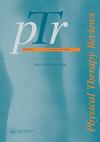远向性水平管良性阵发性位置性眩晕的介入治疗:系统综述
IF 0.8
Q4 REHABILITATION
引用次数: 1
摘要
摘要背景2021年的一项系统综述报告称,所有纳入的治疗向地水平管良性阵发性位置性眩晕(BPPV)的手法均显示出较高的疗效和较少的禁忌症。然而,关于水平管BPPV的无向地亚型的类似系统综述尚未发表。目的本系统综述的目的是评估目前治疗无向性水平管BPPV的有效性。方法从成立到2021年访问的数据库为CINAHL Complete、PubMed和Web of Science。使用的搜索词是(年龄相关或无地理相关)和(水平或横向)和眩晕。Medlicott和Harris开发的10项工具用于评估方法的严谨性。结果其中三种手法(Gufoni手法、Zuma手法和Cupulolith复位手法)仅在一次治疗后就显示出100%的疗效。Gufoni动作可能更适合老年人、肥胖者或行动不便的人,因为它不需要个人进行翻滚。尽管祖马动作也很容易对这些类型的人进行,但只有一项关于这种动作的研究完成。因为Cupulolith重新定位动作是一种滚转动作,所以可能不是所有人都能容忍。结论Gufoni机动可能是最初考虑的最佳机动,因为它比Zuma机动得到了更好的研究;并且对于某些类型的个体来说,它可能比Cupulolith重新定位策略更舒适。本文章由计算机程序翻译,如有差异,请以英文原文为准。
Interventions for apogeotropic horizontal canal benign paroxysmal positional vertigo: a systematic review
Abstract Background A 2021 systematic review reported that all of the included maneuvers for the treatment of geotropic horizontal canal benign paroxysmal positional vertigo (BPPV) demonstrated high efficacy and few contraindications. However, a similar systematic review for the apogeotropic subtype of horizontal canal BPPV has not been published. Objectives The purpose of this systematic review was to evaluate the effectiveness of current treatment options for apogeotropic horizontal canal BPPV. Methods The databases accessed from inception through 2021 were CINAHL Complete, PubMed, and Web of Science. The search terms utilized were (ageotropic OR apogeotropic) AND (horizontal OR lateral) AND vertigo. A 10-item tool developed by Medlicott and Harris was utilized to assess methodological rigor. Results Three of the included maneuvers (the Gufoni maneuver, the Zuma maneuver, and the Cupulolith Repositioning maneuver) demonstrated 100% efficacy after only one treatment session. The Gufoni maneuver may be preferable for individuals who are elderly, obese, or have problems with their general mobility because it does not require the individual to perform a roll. Although the Zuma maneuver is also easy to perform on these types of individuals, only one study has been completed on this maneuver. Because the Cupulolith Repositioning maneuver is a roll maneuver, it may not be tolerated by all individuals. Conclusions The Gufoni maneuver may be the best maneuver to initially consider because it has been more well-studied than the Zuma maneuver; and it may be more comfortable than the Cupulolith Repositioning maneuver for certain types of individuals.
求助全文
通过发布文献求助,成功后即可免费获取论文全文。
去求助
来源期刊

Physical Therapy Reviews
REHABILITATION-
CiteScore
1.30
自引率
0.00%
发文量
26
期刊介绍:
Physical Therapy Reviews is an international journal which aims to publish contemporary reviews, discussion papers and editorials within physical therapy, and in those basic and clinical sciences which are the basis of physical therapy. The journal is aimed at all those involved in research, teaching and practice within the area of physical therapy. Reviews (both descriptive and systematic) are invited in the following areas, which reflect the breadth and diversity of practice within physical therapy: •neurological rehabilitation •movement and exercise •orthopaedics and rheumatology •manual therapy and massage •sports medicine •measurement •chest physiotherapy •electrotherapeutics •obstetrics and gynaecology •complementary therapies •professional issues •musculoskeletal rehabilitation
 求助内容:
求助内容: 应助结果提醒方式:
应助结果提醒方式:


